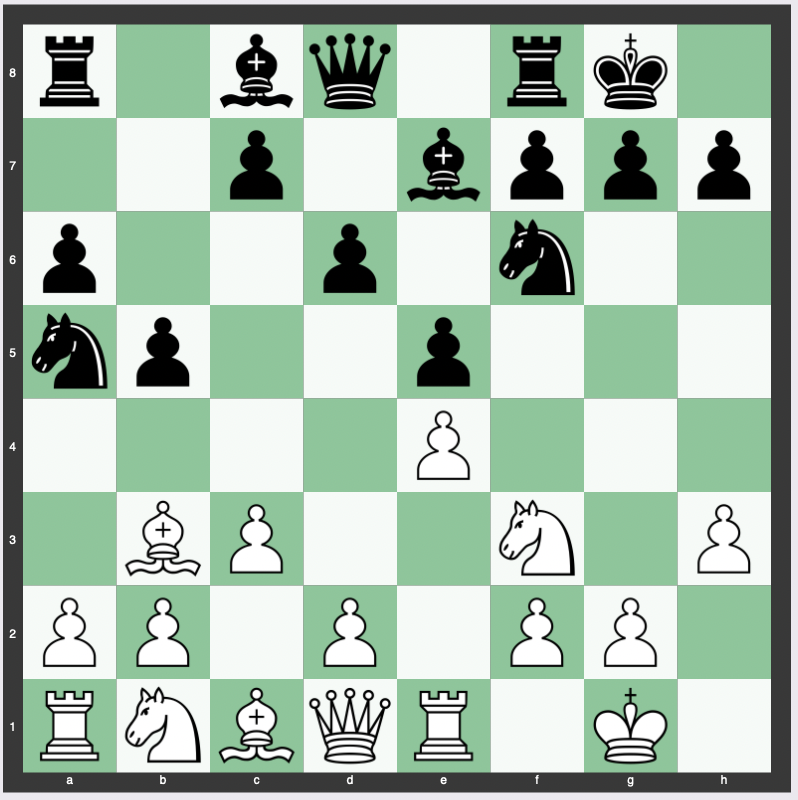The Chigorin Variation is a fascinating and complex line in the Ruy Lopez, one of the oldest and most respected chess openings.
It is named after the Russian chess player Mikhail Chigorin, who was one of the leading players of his time.
The Chigorin Variation is reached after the moves 1. e4 e5 2. Nf3 Nc6 3. Bb5 a6 4. Ba4 Nf6 5. O-O Be7 6. Re1 b5 7. Bb3 d6 8. c3 O-O 9. h3 Na5.
This article will explore the move order, theory, strategy, and purpose of this variation, as well as its history, suitability for different levels of players, and its frequency of play at the Grandmaster level.
Move Order of the Chigorin Variation
The Chigorin Variation follows a specific sequence of moves that leads to a unique position on the chessboard.
As mentioned the Chigorin System goes: 1. e4 e5 2. Nf3 Nc6 3. Bb5 a6 4. Ba4 Nf6 5. O-O Be7 6. Re1 b5 7. Bb3 d6 8. c3 O-O 9. h3

This is then followed by 9…Na5 like in the Pilnik and Suetin Variations.

This move order allows Black to challenge White’s central control and prepare to fianchetto the bishop.
Theory, Strategy, and Purpose of the Chigorin Variation
The Chigorin Variation is rich in strategic ideas and tactical opportunities.
The purpose of this line is to create an unbalanced position where both sides have chances.
Black’s 9…Na5 aims to challenge the Bb3 bishop and create counterplay on the queenside.
White’s plan often involves central expansion and kingside attacking possibilities.
Understanding the underlying theory and strategy is essential for playing this variation effectively.
The Chigorin System leads to a clear positional advantage for white of approximately +0.60 to +0.80.
Sub-Variations of the Chigorin Variation
There are several sub-variations within the Chigorin Variation, depending on the responses from both players.
One of the main lines continues with 10. Bc2 c5, where Black aims for central expansion.
Other possibilities include 10…Nxb3 and 10…Bb7, each leading to different types of positions and strategic themes.
The C98 and C99 Chigorin Variations go as:
- C98 Ruy Lopez, Closed, Chigorin, 12…Nc6
- C99 Ruy Lopez, Closed, Chigorin, 12…cxd4
The C98 Chigorin System variation is shown below:

The C99 Chigorin System variation is shown below:

Exploring these variations can provide a deeper understanding of the Chigorin’s complexity.
Continuation Lines in the Chigorin Variation
Sample continuation lines in the Chigorin System include:
10. Bc2 c5 11. d4 exd4 12. cxd4 cxd4 13. Nxd4 Bd7 14. Nc3 Re8 15. Nce2 Bf8 16. Ng3 Rc8 17. b3 Nc6 18. Bb2 Nxd4 19. Bxd4 Nd5 20. Rc1 Nb4 21. Bb1 d5 22. Bb2 dxe4 23. Nxe4 Rxc1 24. Qxc1
10. Bc2 c5 11. d4 exd4 12. cxd4 cxd4 13. Nxd4 Re8 14. Nc3 Bd7 15. Nce2 Rc8 16. Ng3 Bf8 17. b3 Nc6 18. Bb2 Nxd4 19. Bxd4 Nd5 20. Qd2 Nb4 21. Bb1 a5 22. Rd1
10. Bc2 c5 11. d4 exd4 12. cxd4 cxd4 13. Nxd4 Bd7 14. b3 Re8 15. Bb2 Nc6 16. Nc3 Rc8 17. Nce2 Bf8 18. Nxc6 Bxc6 19. Ng3 Ba8 20. a4 d5 21. axb5 axb5 22. e5 Ne4 23. Bd4 Qh4 24. Bxe4 dxe4 25. Nf5 Qf4
10. Bc2 c5 11. d4 exd4 12. cxd4 cxd4 13. Nxd4 Bd7 14. Nc3 Re8 15. Nce2 Bf8 16. Ng3 Rc8 17. b3 Nc6 18. Nxc6 Bxc6 19. Bb2 Ba8 20. Rc1 g6 21. Bb1 Bg7 22. Rxc8 Qxc8 23. Qd2 Bb7 24. f3 Qc5+ 25. Kh2
10. Bc2 c5 11. d4 cxd4 12. cxd4 exd4 13. Nxd4 Bd7 14. Nc3 Re8 15. b3 Nc6 16. Be3 b4 17. Nce2 Bf8 18. Ng3 d5 19. Nf3 Nxe4 20. Nxe4 dxe4 21. Bg5 f6 22. Bxe4 fxg5 23. Qd5+ Kh8 24. Rad1 Rc8 25. Qxd7 Qxd7 26. Rxd7 Ne5
10. Bc2 c5 11. d4 cxd4 12. cxd4 exd4 13. Nxd4 Bd7 14. b3 Nc6 15. Nc3 Re8 16. Be3 Rc8 17. Rc1 Qa5 18. Bb1 Ne5 19. Nde2 b4 20. Nd5 Nxd5 21. Qxd5 Qxd5 22. exd5 a5 23. f4 Ng6
History of the Chigorin Variation
The Chigorin Variation is named after Mikhail Chigorin, a prominent Russian chess player of the late 19th and early 20th centuries.
He was known for his creative and aggressive style, and the Chigorin Variation reflects these characteristics.
This line has been played by many great players throughout history and continues to be a subject of study and exploration.
Is the Chigorin Variation Good for Beginners or Intermediates?
The Chigorin Variation can be a challenging line to play, particularly for beginners.
Its complexity and the need for a deep understanding of strategic themes may make it more suitable for intermediate and advanced players.
However, studying this variation can provide valuable insights into chess strategy and tactics, even for those new to the game.
How Often Is the Chigorin Variation Played at the Grandmaster Level?
The Chigorin Variation is not as popular at the Grandmaster level as some other lines in the Ruy Lopez.
However, it is still played occasionally and can lead to rich and complex battles.
Some Grandmasters have used it as a surprise weapon, and it remains a viable option in top-level play.
The Ruy Lopez, Chigorin Variation #2 | Chess Openings Explained
Conclusion
The Chigorin Variation of the Ruy Lopez is a rich and complex chess opening that offers exciting possibilities for both White and Black.
While it may not be the best choice for complete beginners, its strategic depth and tactical richness make it an appealing option for intermediate and advanced players.
Its history, variations, and occasional appearances at the Grandmaster level add to its intrigue and make it a fascinating subject of study for chess enthusiasts of all levels.


